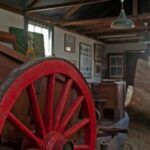Knysna museum
The Knysna museum complex consists of 5 buildings. The first is Millwood House, which was originally built in the Millwood mining village in the Knysna forest. This was the site of South Africa’s first gold rush, albeit a short one. Entire buildings were dismantled and moved to Knysna after the mines were closed. It’s one of five buildings that make up the Knysna Museum.
The Millwood story
Millwood’s story began when James Hooper discovered gold-bearing gravel in a creek on the farm Ruigtevlei near Rheenendal. Chemist William Groom confirmed Hooper’s findings, and the creek was later named Jubilee Creek to honour Queen Victoria’s Jubilee. The discovery drew prospectors, prompting the Cape Government to fund further exploration. Engineers like Charles Osborne and geologists such as Thomas Kitto and E. J. Dunn identified traces of alluvial gold. The government opened the area for public diggings in 1886.
News of gold spread quickly, attracting miners from the United Kingdom, California, and Australia. By 1887, Millwood had 135 stands, hotels, stores, a hospital, and police barracks. A weekly mail service linked Millwood to Knysna, later increasing to three deliveries per week. Mining companies, including the Bendigo Gold Mine, imported advanced equipment from as far as Australia.
The gold rush peaked in 1887, with alluvial and reef claims covering the area. The first year of mining produced 656 ounces of gold, including large nuggets. Millwood seemed poised for lasting prosperity.
However, by late 1888, gold yields declined. Reserves were smaller than expected, and most mining companies incurred losses. By December 1890, nearly all operations ceased. Millwood’s population dwindled as prospectors left for better opportunities, particularly on the Witwatersrand reef.
In 1876, farmer James Hooper found the first deposits of alluvial gold in the Karatara River. Alluvial gold was also found in other streams such as Jubilee Creek. The area was declared open for public diggings in 1886, and John Barrington was appointed the official Gold Commissioner. Only 656 ounces of gold was ever extracted, but a small village sprang up in the Goudveld area of the Knysna Forests. Shops, hotels, banks, and bakeries appeared, but most structures are now gone. The only building that survived is the Monk’s Store, also known as the Materolli.
The name Millwood comes from a sawmill powered by a nearby creek. By the time Parkes Cottage was built in 1890, the gold rush had ended. The cottage was later dismantled, moved, and reassembled several times—first to Knysna’s main square, then Rawson Street, and finally Queen Street. It served various purposes, including housing the South African Legion. Today, it is part of a museum complex featuring displays about Millwood’s history.,
You can take a walk of the old Millwood goldfields. Stroll the 5.6km Millwood Mine walk on the streets that are now empty and overgrown, tourists also get to see some of the old 19th-century machinery, such as a huge steam engine, jaw crusher, stamp battery, and boiler where they were left when miners abandoned the goldfields. There is a little tearoom and photo museum in the only one left of some 70 buildings at Millwood, that is open for visitors to come to explore.
Read about the Old Gaol here
Read about Parkes shop here
Read about Pitt Street House here


